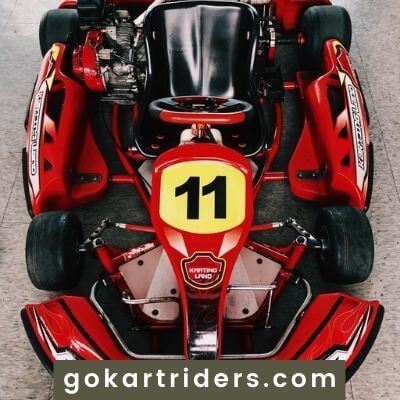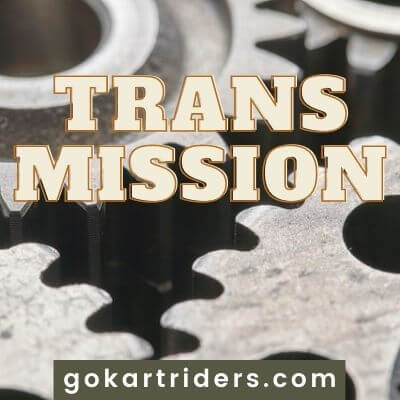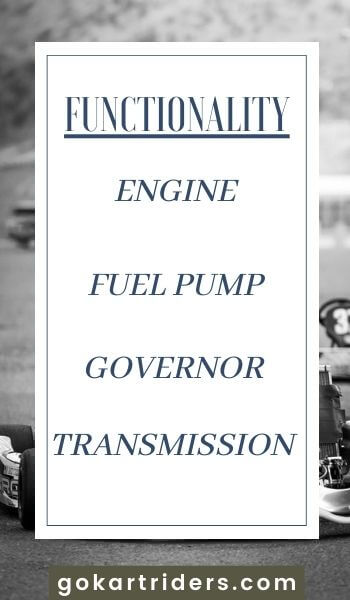Go-kart can be a good way to have fun with your friend and family. There are many tracks available all over the US where you can drive and race in a controlled environment. In this article, I’ll take you through the whole process of how does a go-kart work.
Go-karting can be the first step for you or your kids to become full-blown licensed drivers. The mechanism is pretty simple compared to a car; hence you can drive it with some basic knowledge.
If you plan to buy a go-kart someday, or maybe a father-son garage project, it’s important to know how different parts of a go-kart function collectively. A go-kart might not be as technical or complicated as a car. Still, lots of things have to work simultaneously to get this vehicle going.
I am dividing this article into two parts here. In the first part, I’ll familiarize you with the different parts of the go-kart. Then in the next part, I’ll describe how these key parts work to run the go-kart.
To engage a larger audience, I’ll keep the explanations simple without any technical jargon. So stay with me as I discuss the functionality of a go-kart.
How Does a Go-Kart Work: Introducing the Parts
Here we are at the introduction segment. First, you’ll get to know about the basic yet key parts of a go-kart. These are just the essential parts that make the go-cart run. Apart from these, a go-kart can have various parts depending on the type.

If you own a car or have basic knowledge about them, you’ll probably recognize these from before. If not, then let’s have a look at different parts of a go-kart. Later we’ll discuss how these parts work.
Engine
Engines can be described as the heart of any vehicle. This is the part that runs the machine, and a go-kart is no different. However, a go-kart engine is totally different from a conventional engine from a car or any other vehicle.
Go-karts usually feature a petrol engine. Additionally, the use of electric and LPG-powered go-karts is getting popular day by day. Let’s have a quick look at these three common go-kart engines.
Petrol Engine: This is definitely by far the most preferred go-kart engine type to date. They might not be good in terms of environment-friendliness, but they deliver the highest amount of power.
Petrol engines have two different types, two-stroke, and four-stroke. I’ll discuss the differences later. For now, know that two-stroke engines are better for high-speed karting because of their lower weight and quick acceleration. On the other hand, four-stroke engines can fall short in power, but they are great for fuel-efficiency.
Some people use a slightly modified petrol engine from cars, while others use gasoline specifically manufactured for go-karts. As these engines burn tons of fuel, they emit fumes and make a loud noise; they are mostly suitable for outdoor racing or extreme go-karting.
Electric Engine: Electric engines came very late to the scene compared to petrol ones. Day by day, they are getting more and more advanced and mainstream. Electric engines also have their own benefits and drawbacks. The main advantage is pretty obvious, the energy efficiency.
Instead of burning fuels, you can charge the batteries that run the engine at home. Other additional benefit includes carbon efficiency, no fumes, near-zero engine noise and lastly, its super low-maintenance.
One considerable weakness here is that the engine can’t run more than half an hour in most cases if it’s a lead-acid battery. However, lithium batteries can last up to 2 hours depending on the surface and engine power. That’s why electric engines are primarily suitable for indoor go-kart racing only.
Gas Engine: Gas engines are similar to petrol ones, except they are powered by gas. These engines are used for outdoor racing go-karts only for the most part. Many know manufacturers like Kohler and Honda are manufacturing these engines today.
A gas engine typically starts from 20 horsepower and can easily go up to 90 horsepower. Like the petrol engine, the emission is the biggest drawback of a gas engine too. Research suggests that the emission from a gas engine can be equivalent to driving a regular car for 350 miles.
Transmission
The purpose of a transmission is to deliver the right amount of power to the right wheel, allowing the kart to run at a given speed. If you have ever ridden a multi-gear bicycle, it would be easy to understand.
On the bicycle, at low gear, the bicycle used to go smoothly at the start. And as you put the chain in a higher gear, it used to be tough to start moving from a stop.

A transmission works the same way, except it’s more of an automated system now. Sometimes the transmission is referred to as the gearbox and the gear trains to provide the necessary speed and torque. Without a well-maintained transmission, your vehicle will use more fuel than it should, and the speed transition won’t be smoother.
Go kart’s transmission system can be divided into two groups; one is the automatic transmission, and the other is control transmission, also known as the manual one.
Among different types of automatic transmissions, centrifugal clutch type and CVT (Continuously Variable Transmissions) are commonly used. Later, we will discuss how each of these transmission systems works.
Fuel Pump
The fuel pump of your plays another crucial role in running your go-kart. Its function is pretty self-explanatory, as it pumps the fuel from the fuel tank to the engine. These fuel pumps come with a fixed lifespan, measured in miles.
After pumping for certain thousand miles, you need to replace it. Depending on the engine type, the fuel tank is either installed inside or outside of the engine.
Usually, mechanical ones are run by the engine itself, while the electric ones are installed near the fuel tank and run by a separate line. Not only does the fuel pump supply the engine with fuel, but the fuel pump also decides the pressure of the fuel supplied to the engine.
Each type of engine requires different types of fuel pressure to run properly. Without a well-maintained fuel pump, you can easily face issues like low fuel pressure, which will result in engine failure. Besides, it can reduce the fuel economy of your go-kart too.
Speed Governor
The speed governor is a mechanical device that controls/ governs the speed limit of the go-kart. As a high-speed vehicle, the speed of a high-end go-kart can easily go up to 200 km. That’s a speed suitable only for race tracks.
But if you want to drive it for recreation or make your go-kart street legal, you need to have a very low-speed limit. That’s exactly where the speed governor comes in. The speed governor works the throttle to limit the speed. Go-karting is often considered the first step of getting into moto sports.
So, if you think your go-kart isn’t reaching its potential speed, a speed governor can be the reason for that. Two types of speed governors are primarily used in go-karts.
One is the mechanical speed governors mainly used for larger and more powerful engines. The second one is the pneumatic speed governors used for midsized and small engines. As a go-kart neither have the control nor the safety of a regular vehicle, speed governor does a crucial job of limiting the speed and keep the driving experience safe.
Besides, to be street legal, you need a have a speed limit of 25mph. So, in that case, a speed governor can make sure the speed stays below that.
The Functionality of the Parts
Now that you know the crucial parts, it’s time to understand how a go-kart works with these parts collectively. The key process mostly starts from the fuel pump and ends at the engine. There are other parts, too, like the frame, chassis, wheels, or steering.

However, I am focusing on the parts that directly work with the engine to make it run. I’ll show how the components introduced above work step by step. Let’s begin.
How Does a Go-Kart Fuel Pump Work?
As I mentioned before, the fuel pump delivers the fuel from the tank to the carburetor. So when you are using a two-cycle or four-cycle petrol engine, you need to get rid of the gravity feed setup and install a fuel pump. As these are pretty smaller in comparison to regular ones, the working mechanism is pretty simple too.
Usually, a fuel pump has three lines to hook up before it can get do its job. One line goes from the fuel tank to the inlet of the fuel pump. Then, another line connects the outlet to the carburetor of the engine. The last one, the pulse line, is used to power up the fuel pump.
The engine’s camshaft operates the diaphragm inside the fuel pump. When the diaphragm is pulled at the bottom dead center, the volume of fuel increase in the chamber; hence the pressure decreases. This way, the fuel pump draws fuel from the tank through the first line.
After that, the diaphragm again returns to the top dead center by the diaphragm spring’s force, pushing the fuel in the chamber through the outlet. Finally, through the second line, that fuel reaches the carburetor. The air and fuel get mixed in the carburetor to produce the necessary energy to run the engine.
How Does a Go-Kart Transmission Work?
As most go-karts today use automatic transmission systems, I will solely stick to discuss the CVT (Continuously Variable Transmission) here. Before understanding how CVT works, let’s talk about the parts a CVT consist of.
Typically a CVT has a high strength belt, a driving pulley (input pulley), and another pulley to figure out the torque (output pulley). Of course, a CVT also has sensors and microprocessors, but these three are the key components here.
Now, both the pulley can have variable diameters because of the chain attached to them when the diameter of one pulley increases, the diameter of the other one decreases automatically to keep the belt tight.
When the diameter of the drive pulley or the input pulley decreases, that indicates a lower gear. If that diameter starts to increase, that means the go-kart is going into a higher gear. Instead of a fixed number of gears, CVT allows you to have an infinite gear ratio. Other benefits of CVT also include less malfunction due to fewer moving parts and a smooth speed transition.
How Does a Go-Kart Governor Work?
The governor basically works by playing with the throttle of the engine. Both the governor type I mentioned above brings the same result. However, how each of these operates is a little different.
Mechanical governor works with fly-balls to sense the speed that ultimately changes the throttle position. When the speed increases, the balls start to spin fast, and the spindle goes down, thus narrowing down the throttle valve.
Simply put, the up-down movement of the spindle with fly-balls controls the throttle position, therefore controlling the air-fuel supply. This way, the speed is controlled by the mechanical governor.
Pneumatic governor’s function depends on the air intake of the engine. According to air velocity, a vacuum is created. Later, a diaphragm attached to the fuel line measures the air vacuum and controls the fuel supply, thus controlling the engine’s speed.
The speed governor may affect the top speed of your go-kart, but it’s not a good idea to get rid of this either. Removing the governor means the engine doesn’t have any barrier from reaching the peak RPM. Instead of removing it, you can try to adjust the governor to increase the top speed.
How Does a Go-Kart Engine Work?
For me, this is the most important yet simple to understand part of a go-kart. I’ll be showing you how petrol and an electric engine function.

Petrol engines are often called two-stroke, and the four-stroke engine runs based on the combustion system. Whether it’s two or four strokes, the mechanism is the same.
To start, the pistons inside the engine cylinder need to go up and down. The piston needs to reach two distinct points in the cylinder, one at the bottom and one at the top.
At first, the piston moves down and reaches the BDC (bottom dead center), allowing the air-fuel mixture into the cylinder. Then the piston moves back again to the TDC (top dead center), closing the fuel intake and compressing the gas.
Next, a spark from the spark plug ignites the gas, allowing the combustion to happen and pushing the piston to BDC again. Then the intake valve opens up again to have the air-fuel mixture.
The movement of the piston makes the drive shaft rotate via a gear. Then the spin of the drive shaft rotates the axle, therefore turning the wheels. Simply put, the rotation from piston movement is delivered to the wheels through the drive shaft/chain.
This is a general breakdown of how the combustion engine of your go-kart works. The stroke indicates the number of complete cycles of the piston.
A four-stroke engine goes through intake, compression, power, and exhaust stages to complete an entire cycle. On the other hand, two-stroke engines go through two stages, one to intake and compress the fuel and the other for power and exhaust.
For an electric engine, the electricity stored in batteries is converted into mechanical energy by the stator, and that energy runs the motor in an electric go-kart. There is no physical fuel here, so no conventional parts like piston or cylinder are required for an electric engine.
Conclusion
Now that we have come to an end, this article should give you a basic idea of how does a go-kart work? As you already might have noticed, it’s far less complex than a regular car you drive. A go-kart is so simple that you can even figure out the parts just by looking at it.
Most go-karts don’t have any covered parts, and engines and other parts mostly stay exposed. I hope the article was simple enough to understand for people who don’t have any prior knowledge about vehicle parts.
Let me remind you again that these are just the essential parts I discussed here, and hundreds of other parts contribute to running a go-kart. Now that you know all about how a goa kart works, it would be much easier to build or fix a go-kart on your own. As a guy informed enough, you can now go and purchase/ build your go-kart.